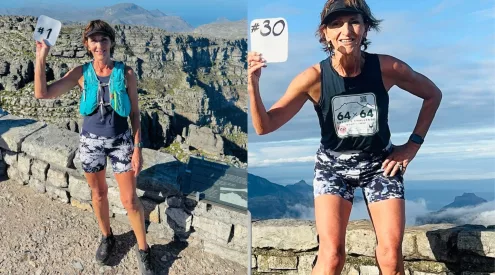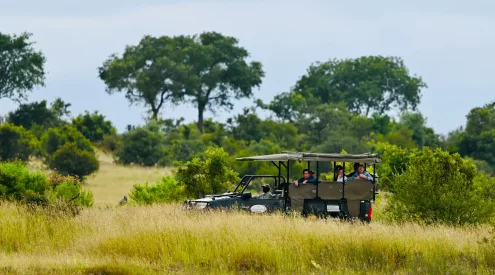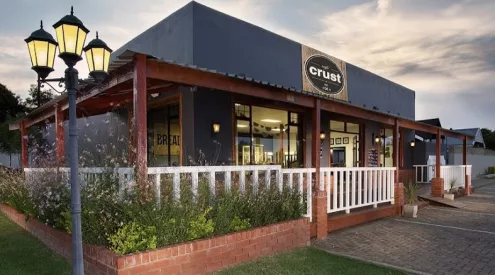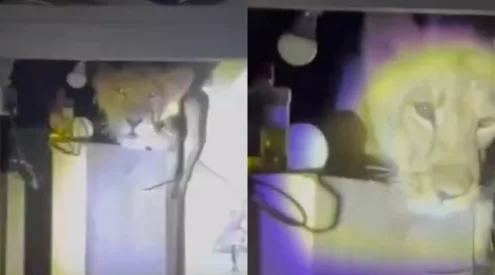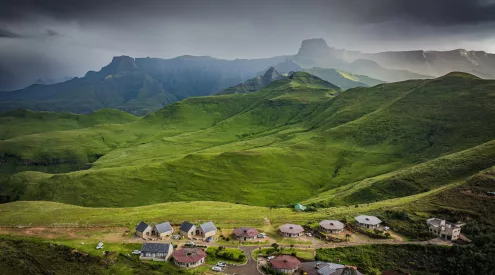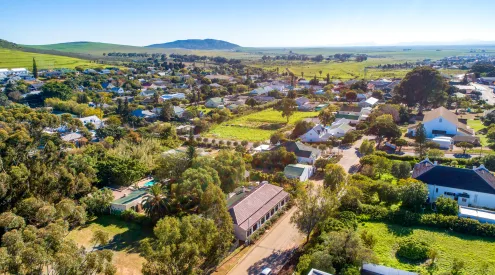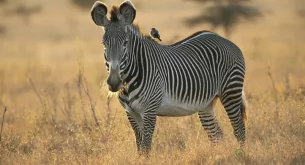Thanks to the MyPlanet Rhino Fund a new light aircraft, the Foxbat A22LS, has been donated to Kruger National Park. It’s an essential addition to Kruger’s anti-poaching strategy.
Getaway‘s Louise Topping travelled to Kruger National Park to check out MyPlanet Rhino Fund’s latest contribution to wildlife conservation.
I’ve never been to Kruger before. I’m slightly ashamed to admit this, and I soon realise how much I’ve been missing out. Perhaps it’s the time of day, nearing dusk, that brings a bounty of game into sight as we wound our way slowly through the bush, from the Paul Kruger gate. We stopped to see giraffes perfectly profiled, a pride of 15 lions strolling along a river bank, a herd of buffalo crossing the road ahead, a fanfare of elephants, and most unexpectedly, a hyena standing silently on the verge. I met its gaze through the window before it loped off into the scrub.

A a herd of buffalo cross the road in Kruger. Image credit: Louise Topping
Despite the excitement of these sightings, I couldn’t help seeking the real jackpot, a rhino. In the two days I spent in the park, I didn’t see one. Kruger holds 60% of South Africa’s rhino population, an estimated 5,000 – 8,000 animals. This the largest remaining population of wild rhino, and its protection necessitates a constant and expensive battle against poaching. An average of three rhino are lost every day to poaching, putting them under severe threat of extinction in the wild.

Left: Giraffe. Right: I lock eyes with the hyena before it lopes off intot he scrub. Image credit: Louise-Topping
“What an indictment on humanity, if the Big 5 becomes the Big 4,” said Braam Malherbe, conservationist and MyPlanet Rhino Fund ambassador.

Braam Malherbe, conservationist and MyPlanet Rhino Fund ambassador. Image credit: Rebecca Hearfield.
Responding to the urgency of this situation the MyPlanet Rhino Fund, administered by the Endangered Wildlife Trust, has raised R2,940,000 in the past year to boost rhino protection in South Africa. More than R1,4 million was donated to SanParks, specifically Kruger National Park. These funds have been used to buy the brand new Foxbat A22LS aircraft.
Kruger’s 4-tiered anti-poaching strategy includes aerial surveillance, some 500 rangers on the ground, a K9 unit including free-running hounds, and community support. The Foxbat is very light on fuel, relatively quiet and very nimble, and needs a mere 60m of runway for take-off. It has a surprisingly wide speed range, from a slow 40 knots (74km/h) hover to a high speed of just over 200km/h. It’s very dinky, and I couldn’t help feeling surprised when pilot Steven Whitfield folded himself into the cockpit with apparent ease.

Foxbat above the hanger. Image credit Rebecca Hearfield.
As Marula North Regional Ranger in the KNP, Steven is one of the integral figures behind the project, even helping with the hanger construction. Co-funded by StopRhinoPoaching.com and MyPlanet Rhino Fund, the hanger is situated near Satara Rest Camp where we are gathered on a rainy morning to witness the Foxbat in action.
As the aircraft banked and glided, it’s low buzz barely broke the stillness of the open savannah. It’s difficult to picture the invisible war waging in the background, one that each of the rangers present faces every day.
“We’re always living on a knife-edge. We are well aware of the risks, but we feel priviledged in this job. We love nature and getting paid in sunsets is the reward” said Robert Bryden, who grew up in Kruger, becoming a guide and eventually Section Ranger in Special Operations due to his excellent tracking and bush skills. He explained “The moment there is a plane, the poachers need to hide which gives us the opportunity to close the gap on the ground and make an arrest. With Steven above and guys on the ground, we have made numerous safe arrests.”

Steven Whitfield eyes a curious hyena. Image: Rebecca Hearfield. Steven Whitfield with the new Foxbat. Image: Louise Topping
Steven confirmed that the Foxbat will be an critical asset in combatting poaching. By identifying high-risk zones, patrolling areas inaccessible by vehicle and on foot, and enhancing rapid response capabilities as poaching trends shift, aerial equipment plays a vital part in remaining a step ahead of the poachers, who are progressively innovative in their strategy and funded by sophisticated crime syndicates.
Rhinos are not the only animals at risk, as Steven said, “Illicit wildlife trade is growing. Rhinos have come to symbolise the fight against this trade. We eat, sleep and live our jobs. Every rhino that you lose hurts like the very first rhino loss.”

MyPlanet-Rhino-panel_memebers(left to right): MyPlanet Rhino Fund Panel members: Steven Whitfield, David Newton (Traffik) Elise Serfontein (StopRhinoPoaching.com), Pieter Twine (MySchool MyVillage MyPlanet General Manager), Ndifelani Mulaudzi (Endangered Wildlife Trust), Braam Malherbe. Image credit: Louise Topping
South Africa risks losing its rich wildlife heritage if we don’t stand together in this battle. With initiatives like the MyPlanet Rhino Fund, making a contribution to conservation has never been so easy.
Get involved
– You can download the free app
– apply for a MySchool MyVillage MyPlanet online at myschool.co.za
– or request a card at a participating retailer.
Every time you swipe they’ll give back a percentage of your purchase value, on your behalf, to the school or charity you choose.

